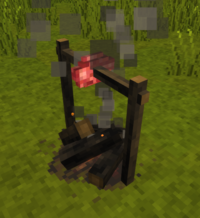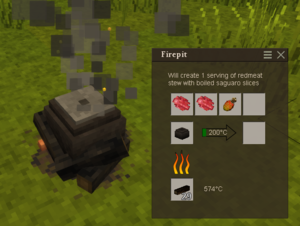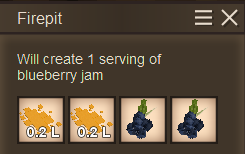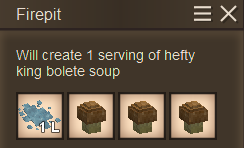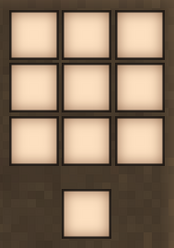Cocina
Comestibles crudos
Al principio del juego, sin ninguna infraestructura, el jugador sólo tiene acceso a alimentos recolectados o cazados que puede comer crudos para mantener su saciedad. Sin embargo, el jugador no debe depender de ellos durante mucho tiempo, ya que una vez recolectados, los alimentos naturales desaparecen para siempre o tardan mucho en volver a crecer.
En la siguiente tabla se enumeran todos los alimentos que pueden consumirse crudos:
| Objeto | Saciedad | Categoría | Notas |
|---|---|---|---|
| Miel1 (por 0,1 litro) | 30 |
Fruit |
Líquido. Nunca se estropea. |
| Cereza, lichi | 40 |
Fruit |
|
| Arándano rojo | 60 |
Fruit |
|
| Fruto del saguaro | 60 |
Fruit |
Restaura 1 CV al consumirlo. |
| Manzana, arándano, grosella roja, grosella blanca, grosella negra, rodaja de mango, naranja, melocotón, pera, granada o piña |
80 |
Fruit |
|
| Fruta del pan | 200 |
Fruit |
|
| Setas | 80 |
Vegetable |
Algunos tipos de setas pueden ser venenosas e infligir daño al consumirlas. |
| Pimiento2, zanahoria, aceituna, cebolla, chirivía o nabo | 100 |
Vegetable |
|
| Yuca (procesada) | 100 |
Vegetable |
No comestible sin tratamiento previo. |
| Repollo | 300 |
Vegetable |
|
| Rodaja de calabaza | 140 |
Vegetable |
|
| Calabaza (entera) | 480 |
Vegetable |
Desde la versión 1.19, ya no es posible comerse una calabaza entera. |
| Grano de lino | 30 |
Grain |
|
| Amaranto, arroz, centeno, espelta o girasol en grano | 60 |
Grain |
|
| Semilla de nuez | 40 |
Protein |
Nunca se estropea. |
| Termitas | 60 |
Protein |
|
| Cacahuates | 160 |
Protein |
|
| Terrón de grasa3 | 200 |
Protein |
Nunca se estropea. |
| Bife Vintage | 280 |
Protein |
Raro botín de ruinas. Restaura 2 CV al consumirlo. Nunca se estropea. |
| Leche (por 0,1 litro) | 15 |
Dairy |
Liquido |
| Pescado | 220 |
Protein |
1 Consumir miel solía restaurar la salud en versiones anteriores. Ya no lo hace a partir de la versión 1.16.
2 A partir de la versión 1.16, los pimientos son imposibles de conseguir en el juego de supervivencia.
3 Los trozos de grasa son un valioso material de fabricación que sólo debe comerse en caso de emergencia.
Hongos
Las setas son especiales en el sentido de que pueden ser beneficiosas o perjudiciales para el jugador cuando se ingieren, y algunas de las perjudiciales se confunden muy fácilmente con las seguras.
A continuación figura una lista de setas específicamente venenosas para facilitar la comprobación:
| Nombre | Notas |
|---|---|
| Boleto amargo | -3 hp |
| Cicuta verde | -50 hp (!) |
| Seta diente de diablo | -2 hp |
| Escleroderma amarillo | -8 hp |
| Seta oreja de ratón | -7 hp |
| Seta matamoscas | -6.5 hp |
| Campana fúnebre | -40 hp (!) |
| Níscalo de leche amarilla | -2.5 hp |
| seta del olivo | -6 hp |
| Mycena rosea | -10 hp |
Cocina básica
La primera oportunidad para hacer mejor comida viene con la hoguera. Un pequeño número de ingredientes recolectados o cazados pueden colocarse directamente en él para su procesamiento. También se puede utilizar para hacer pan, aunque el resultado será de menor calidad que con un horno.
En la siguiente tabla se enumeran todos los alimentos que se pueden procesar en la hoguera:
| Item | Satiety | Category | Notes |
|---|---|---|---|
| Cooked cattail or papyrus root | 100 |
Vegetable |
|
| Cooked bushmeat | 120 |
Protein |
|
| Cooked poultry | 200 |
Protein |
|
| Cooked redmeat | 280 |
Protein |
|
| Cooked fish | 200 |
Protein |
|
| Charred flax bread | 100 |
Grain |
Requires prior processing. |
| Charred amaranth, cassava, rye, spelt, or sunflower bread | 210 |
Grain |
Requires prior processing. |
| Charred rice bread | 220 |
Grain |
Requires prior processing. |
Advanced cooking
Advanced cooking techniques can greatly increase the food value of ingredients, and can potentially achieve several thousands of satiety points in a single food item. Additionally, it allows the player to make meals out of multiple ingredients, which can potentially supply multiple nutrition groups at he same time. Whenever possible, it is recommended that the player uses advanced cooking techniques.
Cooking meals
- See also: Meal
Cooking a meal is an advanced cooking method that increases the food values of all ingredients used and provides additional benefits and convenience. Cooked meals can be kept fresh for very long times in sealed crockpots; eating meals will outright halt satiety loss for a time; eating warm meals will warm the player up; and the player will never waste any food from a meal when it provides more satiety than they need. Instead, they simply leave a partially-eaten serving that can be finished at a later time.
To begin, craft at least one bowl and one cooking pot using the clay forming mechanic, and fire them like all ceramics in a pit kiln. Placing the fired cooking pot into the firepit input slot (upper left) will open up an additional four-slot inventory above the input slot, in which ingredients can be combined into one of the five available meal types. The meal type players create is determined by which two "required" ingredients are placed into the cooking pot first.
- To cook a single serving of a meal: place one of each required item into two separate cooking pot slots (this defines the meal type). For example, a porridge requires "two grain", so a player must add two individual pieces of grain in any two input slots in the cooking pot. Placing two grain in one input slot of the cooking pot will not create a porridge. Adding "optional" ingredients in the other two input slots of the cooking pot will increase the nutrition value and satiation of the meal depending on which items are added. When a valid meal recipe (combining correct ingredients) is placed into the input slots, a message will appear in the cooking pot dialog box informing players about what type of meal will be created after cooking.
- To cook multiple servings of a meal: increase the number of ingredient items added to all slots equally. The cooking pot allows players to cook up to 6 servings of any meal at a time. When creating multiple servings all the items in the input slots must be increased by the same amount, or the food will not cook!
- To cook meals requiring liquids: liquids like water or honey can be added in 1L increments with a bucket, or 0.1L increments with a bowl - however the 0.1L increments are for now only required for jam made from honey. While holding the container with the mouse,
 to add one portion,
to add one portion,  to remove it again.
to remove it again. - To fill a bowl: A bowl holds one meal portion and may be filled from a cooking pot or food storage crock. To fill a bowl, place the container of cooked food onto a solid surface. With the empty bowl in the active hand use
 on the cooking pot or crock. Bowls and crocks may be filled with meals while the cooking pot is in the firepit. Bowls of food may be carried in player inventories, stored in stationary containers, and placed on shelves. Bowls cannot be filled from crocks on shelves.
on the cooking pot or crock. Bowls and crocks may be filled with meals while the cooking pot is in the firepit. Bowls of food may be carried in player inventories, stored in stationary containers, and placed on shelves. Bowls cannot be filled from crocks on shelves. - To eat a meal: Food may be consumed from a filled bowl. With the filled bowl in an active hotbar slot, eat using
 . Players will eat until full, which may leave partial portions of food in the bowl.
. Players will eat until full, which may leave partial portions of food in the bowl. - To store meals: Four portions of any cooked meal can be stored in an empty crock. Place the pot onto the ground or table and right click the pot with an empty crock to transfer meals to the storage crock. Storage crocks may be sealed for long term storage using fat or wax in the crafting grid. Crocks may also be carried in player inventories, stored in stationary containers, and placed on shelves.
Meal recipes
| Advanced recipes | Meat stew | Vegetable stew | Porridge | Soup | Jam | Scrambled eggs |
|---|---|---|---|---|---|---|
| Required ingredients | 2 poultry or red meat or raw fish (cured or fresh) | 2 vegetables or soybeans | 2 grain | 1 vegetable (fresh) + 1L water1 | 2 fruit + 2x 0.2L honey1 | 2 egg |
| Optional protein | 0 - 2 protein | 0 - 2 soybean | 0 - 1 poultry or red meat or raw fish (cured or fresh), or egg | |||
| Optional vegetable | 0 - 2 vegetable | 0 - 2 vegetable | 0 - 2 vegetable | 0 - 2 vegetable | 0 - 2 vegetable | |
| Optional grain | 0 - 2 grain | |||||
| Optional fruit | 0 - 1 fruit, 0L - 0.2L honey1 | 0 - 2 fruit, 0L - 0.2L honey1 | ||||
| Optional dairy | 0 - 2 cheese |
1 Liquids can be added to the pot with a bucket (1L portions), jug (0.3L portions), or bowl (0.1L portions). Pick up the liquid container with your cursor and drag it over an empty spot in the cooking pot. Use ![]() to add one portion,
to add one portion, ![]() to remove one portion.
to remove one portion.
Meal food values
The satiety received from eating meals is equal to the sum of its ingredients. The ingredients added to create the meal determine how much satiety of each class of nutrition the player receives. In addition, the food values of most ingredients are increased via cooking, as shown in the table below.
Pickled variants of listed ingredients can be used, but provide only their tooltip-listed food value, without gaining any bonus from meals.
Ingredients not listed in this table cannot be used in cooking pot meals.
Note: for every 100 satiation filled by consuming a meal, an additional 30 seconds passes before the player's satiety bar starts dropping again for any reason. Consuming a large meal can result in more than five minutes of completely free healing, sprinting, heavy armor wearing, or other strenuous tasks.
|
Protein |
Satiety in a meal |
Vegetable |
Satiety in a meal |
Grain |
Satiety in a meal |
Fruit |
Satiety in a meal |
Dairy |
Satiety in a meal |
|---|---|---|---|---|---|---|---|---|---|
| Soybean | 240 | Field vegetable1 or olive | 150 | Flax grain | 120 | Blueberry, red currant, white currant or black currant | 120 | Blue cheese (slice) | 200 |
| Egg | 200 | Cassava | 120 | Rice grain | 280 | Tree fruits2 or pineapple slice | 120 | Cheddar (slice) | 240 |
| Poultry, cured or fresh | 375 | Pumpkin slice | 180 | Rye or spelt grain | 240 | Cranberries or saguaro fruit3 | 90 | ||
| Redmeat, cured or fresh | 420 | Cabbage | 450 | Amaranth or cassava grain | 240 | Honey (0.2L) | 80 | ||
| Mushroom3 | 120 | Sunflower grain | 240 | Breadfruit | 250 | ||||
| Cherry or lychee | 60 |
1 Field vegetables include carrots, parsnips, onions, turnips, and bell peppers.
2 Tree fruits include apples, mangoes, oranges, peaches, pears, and pomegranates.
3 Ingredients that restore player health when eaten raw, such as saguaro fruit, lose this benefit when cooked. However, cooking a poisonous mushroom does not remove its harmful effects - the meal will still damage the player!
Horneado
Baking is an advanced cooking method that revolves around dough, the creation of which requires some setup. A quern must be available, which requires metal tools to craft. Additionally, a clay oven should be set up for baking, as not all recipes can be baked in the firepit, and the results there are always subpar. Plus, a wooden bucket, a jug or a bowl is needed to be filled with water. Finally, a farm is required to consistently supply useful amounts of grain, as wild crops are nonrenewable, mature extremely slowly, and reset their growth after reaching maturity.
A cambio, hornear es una de las mejores formas de procesar granos que existen en el juego, con un multiplicador de rendimiento de hasta cinco veces en comparación con comer el grano crudo.
Para crear la masa, prepare la harina utilizando un molino para moler el grano y, a continuación, mezcle la harina con agua.
- Abre la GUI del molino y añade grano en la ranura de entrada a la izquierda del molino.
- Mantén pulsado
interactuar en la parte superior del quern para moler el grano y convertirlo en harina, que aparecerá en la ranura de salida a la derecha del molino.
En fases posteriores del juego, se puede utilizar un molino de viento para hacer girar el molino. - En la grilla de fabricación, combina un cubo de agua y harina para crear masa. Cada harina consumirá una unidad de agua del cubo (1L).
Two foods can be baked at the moment: bread and pie. Both of them represent a significant advantage over consuming grain as porridge, and fully-filled pies can grant enormous nutrition with long spoilage times. Each serving of pie also halts the hunger meter for 30 seconds, greatly helping players with high hunger rates due to equipping heavy armor or offhand items.
Almacenamiento de Comida
Consulta la página conservación de alimentos para saber cómo conservar mejor todas esas deliciosas comidas.
Video Tutoriales
| Cocina en cazuela de barro (sin cambios reales desde la versión 1.12) |
|---|
| Food and Cooking | |
|---|---|
| Finding food | Foraging • Farming • Animal husbandry • Cooking |
| Edibles | Fruit • Vegetable • Meat • Grain • Mushroom • Honey • Cheese |
| Meals | Vegetable stew • Meat stew • Soup • Porridge • Scambled eggs • Bread • Pie |
| Food preservation | Pickles • Cured meat • Jam • Cheese • Alcohol • Cellar |
| Cooking tools | Firepit • Clay oven • Cooking pot • Quern |
| Utensils | Bowl • Crock • Storage vessel |
| Other links | Room • Satiety |
| Wiki Navigation | |
|---|---|
| Vintage Story | Guías • Preguntas más frecuentes (FAQ) • Vintage Story Original Soundtrack • Versiones • Controles |
| Mecánicas de juego | Fabricación • Talla Lítica • Alfarería • Herrería • Cocina • Temperatura • Hambre • Minería • Estabilidad temporal • Energía mecánica • Comercio • Agricultura • Ganadería |
| Mundo | Generación del Mundo • Biomas • Clima • Tormentas temporales |
| Objetos | Herramientas • Armas • Armadura • Ropa • Mochilas • Materiales • Comida |
| Bloques | Terreno • Plantas • Decorativo • Iluminación • Functional • Minerales |
| Entidades | Entidades hostiles • Animales • NPCs • Jugadores |
| Miscellaneous | List of client commands • Lista de comandos del servidor • Creative Starter Guide • Bot System • Cómo utilizar Worldedit • Cinematic Camera • Adjustable FPS Video Recording • ServerBlockTicking |
